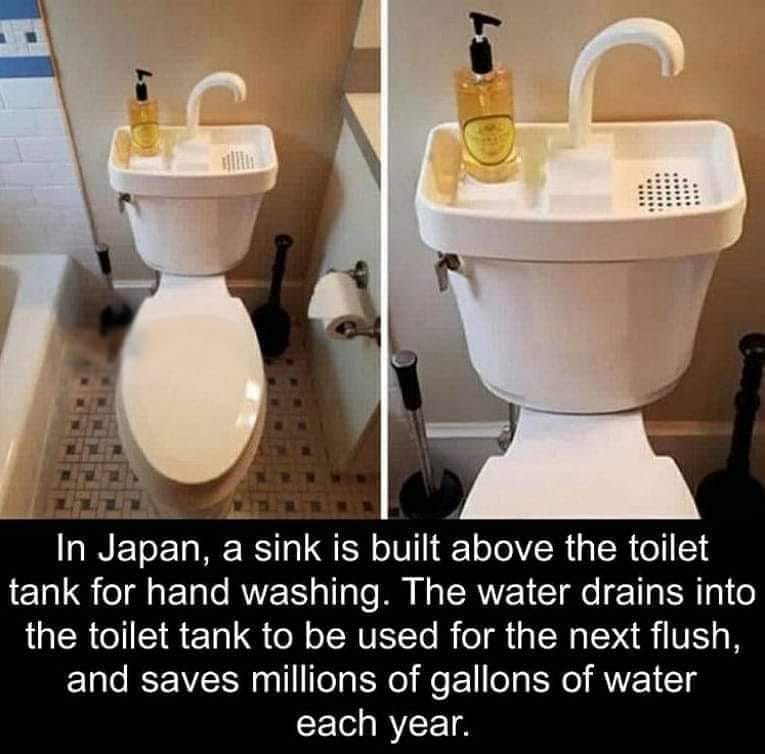Have you ever noticed a sink placed directly above a toilet and wondered, “What’s the reason behind this setup?” In Japan, this innovative design isn’t just a matter of space-saving; it’s a remarkable reflection of the country’s dedication to sustainability and efficient resource use. The sink-over-toilet system exemplifies a simple yet impactful way to minimize waste, benefiting both the environment and everyday life. Let’s dive into how this unique concept functions, its purpose, and why it’s an idea the rest of the world should adopt.

At its core, the sink-above-toilet design is both clever and practical. Here’s how it works: when you flush the toilet, clean water flows into a small sink positioned atop the toilet tank. This water is used for washing hands, and instead of draining away, the used water is redirected into the toilet tank to be stored for the next flush. By serving two purposes—handwashing and flushing—this system significantly reduces water waste while maintaining hygiene and functionality.
This design might initially seem unconventional, but its brilliance lies in its simplicity and effectiveness. It transforms a routine activity into a sustainable process, embodying the principle that even small adjustments can make a big difference. By seamlessly integrating two essential functions, the sink-over-toilet system highlights how thoughtful design can enhance everyday life while addressing global concerns like water conservation.
So, why did Japan adopt this setup? The reasons are deeply rooted in the country’s cultural values and practical considerations. Japan has long been recognized for its commitment to environmental responsibility and efficient use of space. The sink-above-toilet system aligns perfectly with these priorities, offering solutions to pressing issues such as water scarcity, limited living spaces, and the promotion of sustainable habits.
Water conservation is a fundamental benefit of this design. In Japan, where mindfulness of natural resources is ingrained in daily life, reducing water waste is a key objective. The sink-over-toilet system allows water used for handwashing to serve a second purpose, dramatically lowering overall consumption. Over time, the impact becomes substantial, with households saving thousands of gallons of water annually while also cutting down on utility bills.
Another driving factor behind this design is space optimization. In densely populated urban areas, where living spaces are often small and carefully planned, the sink-above-toilet concept is a game-changer. By combining two bathroom essentials into one compact unit, the system frees up valuable room without sacrificing functionality. It’s an ideal solution for apartments, tiny homes, and other environments where every square inch counts.
The design also encourages sustainable living habits. Each time someone washes their hands, they are reminded of the importance of resourcefulness. This daily reinforcement fosters a culture of mindfulness and environmental consciousness, making sustainability a natural part of life. It’s not just about saving water—it’s about instilling a mindset that values thoughtful and efficient use of resources.
Beyond its environmental and practical advantages, the sink-over-toilet system offers undeniable economic benefits. By reducing water usage, households can enjoy lower water bills while contributing to broader conservation efforts. The system is also highly hygienic, as the water used for handwashing is clean and never comes into contact with the toilet’s contents, ensuring safety and cleanliness.
The design’s global potential is immense. In regions facing water scarcity, this system could play a crucial role in conserving limited resources. Similarly, in rapidly urbanizing areas, where space is at a premium, the compact nature of the sink-over-toilet system offers a smart solution for maximizing functionality without expanding footprints. From residential bathrooms to office restrooms and public facilities, the applications are endless.
If this idea has inspired you, incorporating it into your own home is easier than you might think. Many plumbing retailers now offer sink-over-toilet units that can be easily installed. Alternatively, you can consult a plumber to retrofit your existing toilet to include this innovative feature. Adopting such a system can be a meaningful step toward reducing your environmental impact while enjoying practical benefits like reduced water bills and optimized space.
The sink-above-toilet design also reflects Japan’s cultural philosophy of mottainai, which emphasizes avoiding waste and making the most of available resources. This principle, deeply embedded in Japanese culture, is a reminder that small changes can lead to significant outcomes. By rethinking how we use water and space, we can make strides toward more sustainable living.
Japan’s leadership in sustainability goes far beyond this one innovation. From high-tech toilets with water-saving features to public spaces equipped with sensor-activated faucets and recycling bins, the country consistently demonstrates how modern living can coexist with environmental responsibility. These advancements collectively create a culture of mindfulness and resourcefulness that benefits individuals and society as a whole.
In conclusion, Japan’s sink-over-toilet system is much more than a quirky bathroom feature—it’s a model of how design can drive positive change. By reusing water and optimizing space, this system encapsulates the principles of sustainability, efficiency, and mindfulness. It’s a testament to the idea that even small innovations can have a profound impact on our daily lives and the planet.
Whether you’re looking to lower your water bills, embrace eco-friendly habits, or make the most of a compact bathroom, this design offers a practical and inspiring solution. The next time you wash your hands, consider where that water might go next. Could it serve a second purpose? If Japan’s innovation is any guide, the answer is an emphatic yes.